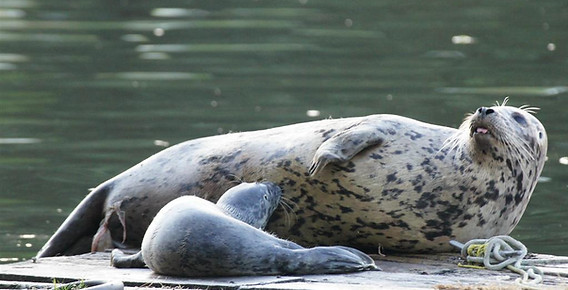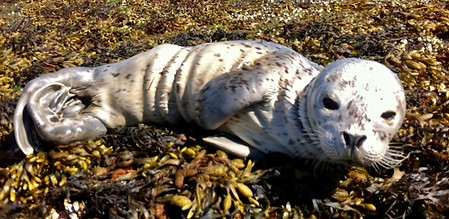Help, we’re orphans!
Our lives are hanging by a thread and the only thing that can make a difference is whether the people who found us get involved and call Island Wildlife, or just walk away.
Keep in mind that these Harbour Seal pups are not only motherless, but are suffering from life threatening viral and bacterial infections such as seal herpes virus, meningitis, umbilical infection, verminous pneumonia, traumatic injuries from boat propellers, and bone crushing injuries from log booms. They are undergoing hypoglycemic convulsions, levels of dehydration and malnutrition that defy survival and are on a beach alone and enduring dog attacks, gulls pecking at their eyes and tourists posing for pictures only to push them back into the frigid ocean.
How can you tell when it is truly an orphan? Let's take a little quiz...

Seal pup (A) is peacefully nursing from its mother who gave birth to it earlier in the day. Some afterbirth can still be seen on the mothers abdomen.
Seal pup (B) born just hours before this photograph was taken has a fresh umbilical chord. This pup is a little frantic as it tries to nurse from the hull of an aluminum boat. Which one is the orphan?


A
B
Seal pup (C) is emaciated and dehydrated. Its eyes are dry and squinty, its skin is loose as if its a couple sizes too large for the body. The pup is lethargic and is the only seal on the beach. Compare how it looks to the pup just to the right. Seal pup (D) is fat and lively with bright moist eyes and in the constant company of its mother. Pup (D) is not the orphan. And look at the size of that mother! Do you sincerely believe that seal must go out foraging for fish and leave her helpless baby alone on the beach, or does it make more sense that she can afford a little weight loss as she fasts for a couple of weeks and intensely cares for her infant.
C
D


E
F

D
You can't always tell an orphan just by the company they keep. If they appear to be with an adult it's helpful to observe and report on the kind of interactions you are witnessing. Pup (E) is clearly with its mother. Riding on mom's back is a favourite mode of transportation. On the other hand, Pup (F) has no mother and appears to be starving. The adult it has hauled-out next to is almost assuredly not its mother. However, if (F) happens to haul-out near a sleeping, lactating seal, an orphaned pup wouldn't hesitate to steal milk as long as the donor slept unaware. In the photograph below right, can't you just imagine that hungry pup slowly creeping up, stretching out its neck to get a drink of mothers milk while staying as far away as possible. When the adult realizes it's not her offspring she will aggressively reject the desperate intruder. Pups B,C and F have no chance to survive if not for a member of the public phoning Island Wildlife.




We are not advocating that the public should walk around grabbing sick pups off the beach at will. However, if you come upon a seal that may be in trouble, looks thin and lethargic, eyes may look dry or crusty and punctures and wounds may be obvious, try and keep people and dogs away and call the Wildlife Centre immediately. It's the informed thing to do and chances are you are going to save a life.
A CBC radio interview with our founder about how it all got started. Have a glimpse into our archive for a behind the scenes look at our pathway to creating
a balance between conventional veterinary and alternative medicine as we build an innovative centre for wildlife and marine mammal rehabilitation.